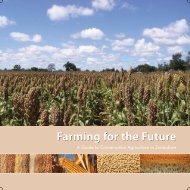Restoring the Soil - Canadian Foodgrains Bank
Restoring the Soil - Canadian Foodgrains Bank
Restoring the Soil - Canadian Foodgrains Bank
You also want an ePaper? Increase the reach of your titles
YUMPU automatically turns print PDFs into web optimized ePapers that Google loves.
Existing Green Manure/Cover Cropping Systems Around The World913. Honduras. Gm/ccs that can effectively controlweeds, such as <strong>the</strong> mucuna in this photo, will begreatly appreciated by farmers.and organic matter from gm/ccs canincrease soil fertility tremendously. As aresult, programs from India to Brazil andthroughout Central America now speaknot just of “soil conservation,” but of “soilrestoration” and “soil recuperation.”3. Zero transportation costs. Unlike mosto<strong>the</strong>r materials that improve <strong>the</strong> soil, <strong>the</strong>seadditions of organic matter and nitrogenhave no associated transportation costs.They are produced right in <strong>the</strong> field where<strong>the</strong>y will be used, and are already welldistributedacross <strong>the</strong> field.4. Very low cost. Gm/ccs cost <strong>the</strong> farmerno money whatsoever once <strong>the</strong> farmer haspurchased his or her first handful of seed.5. Weed control. Gm/ccs can also be animportant factor in reducing <strong>the</strong> cost and<strong>the</strong> labor required for controlling weeds(Photo 13). Especially in Africa, this often means that women’s total workloads can bereduced by 20% or more.In Africa, a particularly noxious weed is striga (Striga hermonthica). Striga can significantlyreduce yields of maize, sorghum and millet, and is a major concern for farmersin areas with low soil fertility. The solution, however, is quite simple. Striga dies out ifenough organic matter is added to <strong>the</strong> soil. Thus almost any gm/cc that produces adecent amount of biomass will gradually rid <strong>the</strong> fields of this weed. 5 In areas wherestriga is a serious problem, this fact in itself will often convince farmers that <strong>the</strong>yshould use gm/ccs.Imperata grass (Imperata cylindrica) is ano<strong>the</strong>r serious weed that grows best in poorsoils and <strong>the</strong>refore becomes less and less problematic as soils recuperate.6. Reduction in <strong>the</strong> use of agrochemicals. If farmers are using chemical fertilizer,gm/ccs can usually reduce <strong>the</strong> amount used by 60% to 80% without lowering yields.Herbicide use is ei<strong>the</strong>r reduced or eliminated, since many gm/cc species are able tosmo<strong>the</strong>r weeds. Some species of gm/cc can be used in place of o<strong>the</strong>r chemicals. Forexample, mucuna and lablab beans kill nematodes, while sunnhemp (Crotalariaochroleuca) can be used to control pests that eat stored grain.7. <strong>Soil</strong> cover. The soil cover provided by many gm/ccs can be very important for soilconservation (Photo 13). In general, <strong>the</strong> value of soil cover (especially in <strong>the</strong> humid5Dyck, E., et al., Legumes in Every Farm, Strategies for Adoption of <strong>Soil</strong>-Improving Legumes by Smallholders in Kenya, 1996.
















